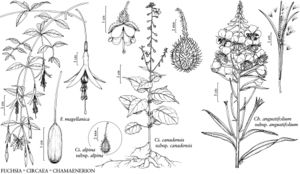Chamaenerion angustifolium subsp. angustifolium
Stems 20–130 cm, subglabrous. Leaves subsessile; cauline blades linear-lanceolate to narrowly lanceolate, (3–) 7–14 (–18.5) × (0.3–) 0.7–1.3 (–2.5) cm, base rounded to cuneate, margins usually entire, rarely low-denticulate, surfaces and veins glabrous. Inflorescences subglabrous; bracts 5–20 mm. Flowers: sepals 6–15 × 1.5–2.5 mm, acute or acuminate; petals obovate to narrowly obovate, 9–15 (–19) × 3–9 (–11) mm, entire or scarcely emarginate; filaments 7–14 mm; anthers 2–2.5 mm; pollen 3-porate (rarely 4-porate), 60–75 µm diam.; ovaries 6–20 mm, style 8–14 mm. Capsules 4–8 cm; pedicels 0.5–2 cm. Seeds 0.9–1 × 0.3–0.4 mm. 2n = 36.
Phenology: Flowering Jun–Sep.
Habitat: Moist, often disturbed, places in mountains or in lower areas, frequent especially after fires.
Elevation: 0–3800 m.
Distribution
Greenland, Alta., B.C., Man., Nfld. and Labr., N.W.T., N.S., Nunavut, Ont., Que., Sask., Yukon, Alaska, Idaho, Minn., Mont., Pa., Utah, Wash., Wyo., Eurasia
Discussion
Plants with white corollas, only a minor variant, sometimes occur. Because of reduced competition in Arctic regions after fires, large populations of subsp. angustifolium may persist for many years.
Selected References
None.
Lower Taxa
"broader" is not a number.
